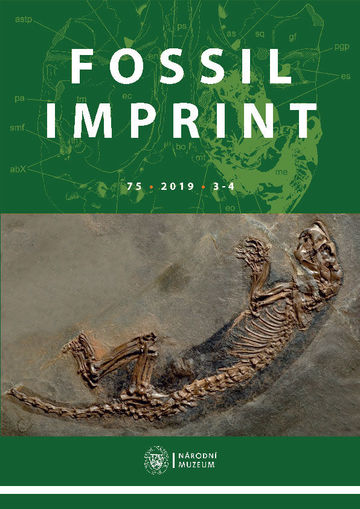
2019/75/3-4
ISSN : 2533-4050 (tisk), 2533-4069 (online)
Vedoucí redaktor : Jiří Kvaček
Vedoucí redaktor : Jiří Kvaček
Gerhard Storch – a legend in mammal research
Ivan Horáček, Thomas Lehmann, Irina Ruf, Katrin Krohmann, Lutz Christian Maul
Rodent Suborders
Lawrence J. Flynn, Louis L. Jacobs, Yuri Kimura, Everett Lindsay
For two hundred years the status of rodent suborders has been unstable. What are the natural groupings of extant rodent families? The formal recognition of rodent suborders has remained challenging and consensus has been elusive. Classically conceived rodent suborders are widely viewed as…
Tooth enamel microstructure in Megasorex gigas (Merriam, 1897) and Cryptotis magna (Merriam, 1895) from Mexico – in comparison to the schmelzmuster in other shrews
Wighart v. Koenigswald
The enamel microstructure of molars in Mexican soricines Megasorex and Cryptotis is described and compared to the six types of schmelzmuster found in fossil and recent Soricidae. These types of schmelzmuster show a high correlation to the current systematics of Soricidae. In Megasorex, the…
Palaeoenvironments of the Manych valley at the end of Late Pleistocene based on rodent and mollusk data from Sanmanych (Rostov District, Russia)
Anastasia K. Markova, Andrey L. Chepalyga, Andrey Yu. Puzachenko
A thorough consideration is given to the geological, palaeotheriological and malacological materials obtained from the Pleistocene Sanmanych locality, which is the only locality with mammal fauna in the Manych depression (46°24′53″ N, 42°36′25″ E). The brackish-water mollusk composition indicated…
Myotis gerhardstorchi sp. n. and comments on the European fossil record of Myotis frater group (Mammalia, Chiroptera)
Ivan Horáček, Eva Trávníčková
A new species, Myotis gerhardstorchi sp. n., supposedly close to M. sicarius and M. frater group, is described from MN 15 site Beremend 26 (Hungary). M. frater group, now restricted to vicariant ranges in E Asia, Siberia and Central Asia, is further reported from three Pliocene and two Early…
Plio-Pleistocene amphibians and reptiles from Central Turkey: new faunas and faunal records with comments on their biochronological position based on small mammals
Elena V. Syromyatnikova, Alexey S. Tesakov, Serdar Mayda, Tanju Kaya, Gerçek Saraç
Small fossil vertebrates from several Pliocene and Pleistocene localities in Central Anatolia (Turkey) are reviewed. Data on small mammals represent assemblages from the early Pliocene (MN 14: Nasrettinhoca 1, 2 and Hamamkarahisar A, B), and late Pliocene (MN 16: Hoyhoytepe 1, 2, 3 and Mercan 1);…
An exceptional large sample of the early Miocene ctenodactyline rodent Sayimys giganteus, specific variation and taxonomic implications
Julian Hartman, Andrew A. van de Weerd, Hans de Bruijn, Wilma Wessels
An assemblage of the early Miocene Sayimys giganteus (Ctenodactylinae, Rodentia) from its type locality Keseköy, and smaller assemblages of Yapıntı and Horlak (Anatolia, Turkey) are described. Almost all Sayimys species are known from small collections of isolated cheek teeth. The very large…
Platacanthomyids (Rodentia, Mammalia) from the late Miocene Yuanmou hominoid locality of Yunnan, China
Zhuding Qiu, Xijun Ni
Remains of platacanthomyids from Leilao, a late Miocene hominoid locality in Yuanmou, Yunnan, China are described. Five species in three genera are recognized: Neocometes sp., Platacanthomys dianensis Qiu, 1989, Typhlomys aff. T. primitivus Qiu, 1989, T. hipparionum Qiu, 1989 and T. storchi n. sp.…
A new Thaumastocyoninae (Amphicyonidae, Carnivora) from the early Miocene of Tuchořice, the Czech Republic
Jorge Morales, Oldřich Fejfar, Elmar Heizmann, Jan Wagner, Alberto Valenciano, Juan Abella
New Amphicyonidae fossil remains from the early Miocene site of Tuchořice (the Czech Republic) confirm the presence of a new Thaumastocyoninae taxon: Peignecyon felinoides n. gen. et n. sp. It is characterized by a peculiar combination of plesiomorphic and derived morphological traits. The new genus…
The early Miocene Bats (Chiroptera, Mammalia) from the karstic sites of Erkertshofen and Petersbuch 2 (southern Germany)
Valentina V. Rosina, Michael Rummel
Fossil bats are described from the karstic deposits of the Erkertshofen 1, Erkertshofen 2 and Petersbuch 2 sites in eastern Bavaria, southern Germany (MN 4). Fossils are discussed with regard to taxonomic, stratigraphic and palaeoecologic significance. The rich fossil material represents at least 12…
New light on Parasorex depereti (Erinaceomorpha: Erinaceidae: Galericini) from the Late Messinian (MN 13) of the Monticino Quarry (Brisighella, Faenza, Italy)
Federico Masini, Andrea Savorelli, Antonio Borrani, Paul P. A. Mazza, Flaviano Fanfani
A large-sized species of Parasorex is common in the MN 13 mammal assemblages from the uppermost Messinian sandy-marly fissure fillings within the Gessoso Solfifera Formation at Brisighella (Northern Apennine). This erinaceid has been classified as Galerix sp. in the first papers on the Brisighella…
A reevaluation of the taxonomic status of the rodent Masillamys Tobien, 1954 from Messel (Germany, late early to early middle Eocene, 48–47 m.y.)
Monique Vianey-Liaud, Laurent Marivaux, Thomas Lehmann
This paper clarifies the identification of the three species referred by Tobien (1954) to the genus Masillamys from Messel, and more specifically provides a revision of their diagnosis and differential dental features, using an updated terminology. Based on specimens better preserved than the…
Skeletal anatomy of the basicranium and auditory region in the metacheiromyid palaeanodont Metacheiromys (Mammalia, Pholidotamorpha) based on high-resolution CT scans
Timothy J. Gaudin, John R. Wible, Kenneth D. Rose, Robert J. Emry, Michelle Spaulding
Cranial skeletal material of the Eocene palaeanodont Metacheiromys marshi was examined using high-resolution CT scans. The present study represents the first time that CT scans have been conducted on skulls of this extinct fossorial mammal. The bony osteology of the auditory region is described in…
A large morganucodontan mammaliaform from the Late Jurassic of Germany
Thomas Martin, Alexander O. Averianov, Kai R. K. Jäger, Achim H. Schwermann, Oliver Wings
An upper “triconodont” molar from the Late Jurassic (late Kimmeridgian) of the Langenberg Quarry in northern Germany is attributed to Storchodon cingulatus gen. et sp. nov. of Morganucodonta. The molar is characterized by continuous lingual and buccal cingula, and a relatively large,…
